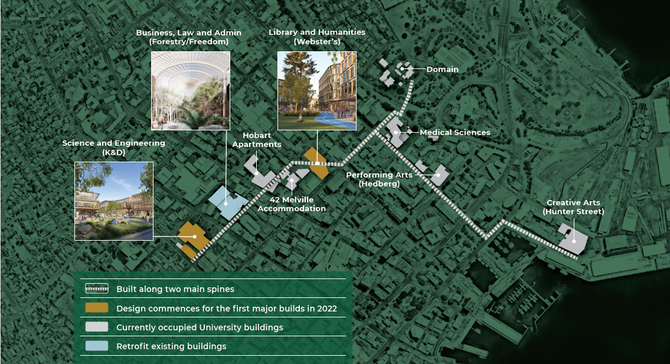Image: Artist impression of the new park at the centre of the West End precinct.
The University of Tasmania must ensure its financial sustainability so that we can fulfil our mission to provide quality higher education to the most diverse range of Tasmanians. This mission is our core business.
So we need to set the record straight. There are no hidden agendas behind the University of Tasmania’s move to Hobart’s CBD.
We’re not seeking any government funding to support the campus move, which is well under way. We have the properties we need in the CBD, including the University’s original home on the Domain. More than 30 per cent of university courses already are based in the CBD.
We’re not dodging rate payments to Hobart City Council, and the repurposing of Sandy Bay will generate revenue at far higher levels than our current CBD real estate holdings.
The university does not have any foreign ownership.
All funds raised from repurposing the Sandy Bay site will be reinvested back into the University, and the teaching and research we will deliver for decades to come.
All Australian universities currently face real funding challenges. First established in 1890, and Australia’s fourth oldest university, the University of Tasmania is no exception. Government funding for higher education has been declining for decades.
Since 1989, the spend by Australian governments on higher education as a percentage of GDP has almost halved, while numbers of domestic bachelor’s degree students have more than trebled. Today Federal government funding per student is around $11 000 per year – compared with $14 000 in 1994, $19 000 in 1984 and $26 000 in 1977, which represents a fall in real terms of almost two thirds.
Additionally, there is no regular capital funding mechanism or allocation of Commonwealth funding to universities.
We have been fortunate to receive State and Federal support through the city deal in the north of the State for our campus relocations, but generally when universities need to upgrade facilities or build new infrastructure, we have to fund it ourselves.
The move from Sandy Bay to Hobart’s CBD positions us to meet these challenges in the most responsible and sustainable way. For the past decades, in the face of this declining funding, we have prioritised teaching and research over infrastructure. Unfortunately, the result is our Sandy Bay campus is no longer fit for the University’s purpose as a contemporary educational provider and workplace.
Even if we sold the CBD assets that we had specifically acquired to house teaching and learning and research activities currently on Sandy Bay, and then used those funds to upgrade the run-down Sandy Bay campus, at estimated current market value this would only generate around $100 million. It wouldn’t touch the sides of the greater than $600 million infrastructure spend required to upgrade and renew everything at Sandy Bay.
More critically, it wouldn’t deliver funds to future proof the University and our mission. Instead, a move into the city enables the University to generate over time more than enough income from the development of Sandy Bay to fund the total rebuild in the city. This will financially support our ongoing teaching and research.
Carefully weighing up our options, it became clear we needed a different approach from ‘business as usual’. The CBD move is a key part of this.
So are initiatives like our recent successful raising of over $350 million in Green Bonds – financial instruments to fund projects with positive environmental and climate benefits – which we’ll use to pay down some of the University’s existing debt and help finance the CBD move. The long-term nature of this bond issue means we can leverage off the current low interest rate environment over a period up to 20 years.
We know we need to work with Tasmanians who care about the University to ensure that people better understand this change. We’ve opened and supported conversations explaining how the campus consolidation will improve access, deliver better facilities and an enhanced learning experience for students.
We’ve outlined our vision for the future of the Sandy Bay site, which includes new dwellings to help address Tasmania’s housing crisis, protects over half of the site as a bushland reserve, and delivers an improved sporting precinct.
These plans are not set in stone, and we continue to welcome community suggestions about the best ways to activate this precinct when the University moves.

Masterplan showing the five interconnected precincts of the city-based campus in nipaluna/Hobart.
The CBD move is a unique opportunity for the University to underwrite our ability to serve Tasmania and its people.
It will better insulate us from the impacts of inadequate government funding, and from the vagaries of the political cycle.
It will help us create the next generation of jobs for Tasmanians who want to study, work and live in Tasmania.
This will be the game changer that sets up the University of Tasmania for the future.
David Clerk is the Chief Operating Officer and a graduate of the University of Tasmania.
Find out more and get in touch about the southern campus we're creating in the city-centre of nipaluna/Hobart.